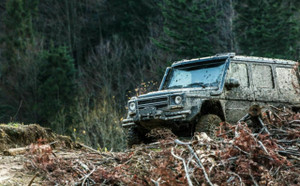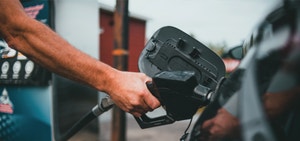How to drive off-road
By Kijiji Autos
So the salesman told you your new 4 wheel drive vehicle is capable of charging through streams, driving over mountains, carving a path through thick forests, and ripping through the desert without even raising a sweat…
There’s just one problem, while your new pick up truck or SUV looks great, you’ve never been off-roading before! While this guide is no substitute for enrolling in an accredited 4WD course, it will help you get more out of your new 4WD vehicle.
Tame The Terrain
Mud and Sand
The trick to getting through mud and sand is to use steady momentum (keep even pressure on the throttle, don’t jerk your foot on and off). When driving in mud, don’t select too low a gear as this will cause your tires to spin rather than grip. Second or even third gear is the way to go. In sand, a lower gear is usually best.
Snow
Use steady momentum when going through deep snow, and don’t select too low a gear, as it will cause tires to spin. If the wheels do spin, ease off the throttle and let the spinning slow to regain traction. Select the highest gear possible for the conditions at hand.
Water
Make sure the river’s safe for you to cross and NEVER attempt to cross a river during a flood. Accelerate as you enter the water slowly to create a bow wave, and then drive at a nice even (slow) pace to avoid overtaking your bow wave (this should sit about one meter off your bumper). Choose a place where the river is wider to cross; while the narrow portions might look more favorable, they are likely deeper than the wider sections, making it more likely that you get stuck!
Hills
Always try and walk the hill, mainly so that you know what’s on the other side of it. Always drive straight-ahead at a hill, never approach from an angle (which could cause your car to rollover), and choose the highest gear the vehicle will ‘pull’ in. On your way down a hill, make sure you’ve stopped and assessed the ground. Pick out a rough path and then, choosing first-gear low range, or 1 in an automatic-equipped 4WD (this will provide the maximum amount of engine braking) set off. If you have hill descent control, use that on your way down.
Airing Down
Means dropping your tire pressures to increase their footprint, which improves traction in soft sand. It’s also worth airing down on rocky terrain as it allows the now soft tire a chance to roll over an obstacle. Make sure you carry an air compressor to re-inflate your tire once you get back to regular terrain.
More Off-Roading Tips
Know exactly how big your vehicle is – that also means knowing its approach and departure angle, ground clearance and ramp over.
Where possible walk the ground you’ll be driving over. A preliminary survey could save you from getting stuck later!
If the hill is too steep, the track too narrow, or the water looks too deep then turn around and find another way to go. Swallowing your pride before you have to get towed is much easier (as well as easier on the wallet).
Keep both hands on the wheel, but never lock your thumbs inside the rim of the steering wheel (kickback could lead to injury).
Tell someone where you are headed, which route you will take, and when you plan to be back (or when they can expect you to check in). You never know what might happen off road.
Check your tires and gear for cuts and pump them back up if necessary.
Don’t set out to go Off-Roading without these items
- Tow rope
- Shovel
- 2-way radio or a comparable communication device. If relying on your cell phone, make sure it is charged and you get reception where you are going.
- Clothing that is appropriate for the climate, should you get stuck outside.
- Footwear that is appropriate for the terrain.
- GPS navigation and maps
- Food and water. Keep a big bottle of water and a stash of power bars, beef jerky, or whatever high energy food you prefer on hand just in case.
- Extra fuel
Did we forget anything? What do you always bring on your off-roading adventures?
Easily find your next ride on Kijiji Autos
Search nowHow Long Can a Car Sit Unused?
How long can a car be left without starting it? Keep reading to explore everything you need to know about unused cars.Costs of Installing an Electric Car (EV) Charging Station in Canada
Installing a home EV charger can come with additional fees beyond purchase and installation. Here's a list of factors that can affect the price of a home EV charger.Toronto to Calgary Road Trip: Routes & Tips
Planning on driving from Toronto to Calgary? Here are some routes and tips to help you along the way.Flat Tire vs Blowout: What's the Difference & What Should You Do?
The main difference between a flat tire and a blowout is that a blowout often feels like an explosion has occurred underneath your vehicle. Blowouts can cause sudden and drastic changes to the handling of your vehicle and can lead to minor or even serious accidents.7 items you can fit in an SUV: TVs, mattresses and more
Discover seven common items that fit in an SUV below.Tips to help protect your vehicle and budget for car repairs
When shopping for your next vehicle, it's always a good idea to keep hidden costs in mind. Before you buy, let's look at how much it can cost to maintain a car in Canada, how much you could budget for annual maintenance and repairs, and how to help protect your car against damage and depreciationThe top three best paint protection options for your vehicle
Buying a new vehicle is a great experience. Nothing beats hitting the road in a car you bought fresh off the lot. However, as fun as it is to finally get behind the wheel of your new ride, it's important to take your time through the process.What is the value of undercoat protection on your vehicle?
When you buy a new vehicle, protecting it so that it lasts as long as possible is definitely top of mind, whether that's through security upgrades or an extra coat of paint. But how often do you consider the care and safety of your vehicle’s undercarriage?Financial guide: post-pandemic car shopping and gas price hacks
With populations locked down and international borders closed the global supply chain has been disrupted on a massive scale, pushing up inflation around the world and raising the cost of everything that people need to get back to normal. Here are a few tips you can use to grab the vehicle you want without breaking the bank.10 tips to help make the road a better and happier place
We have all, at some point, been responsible for making the roadways stressful in one way or another. Alternatively, we are all equally capable of making the road a happier place. Let’s explore 10 unique ways we can help make the driving experience better again, for everyone's sake.








